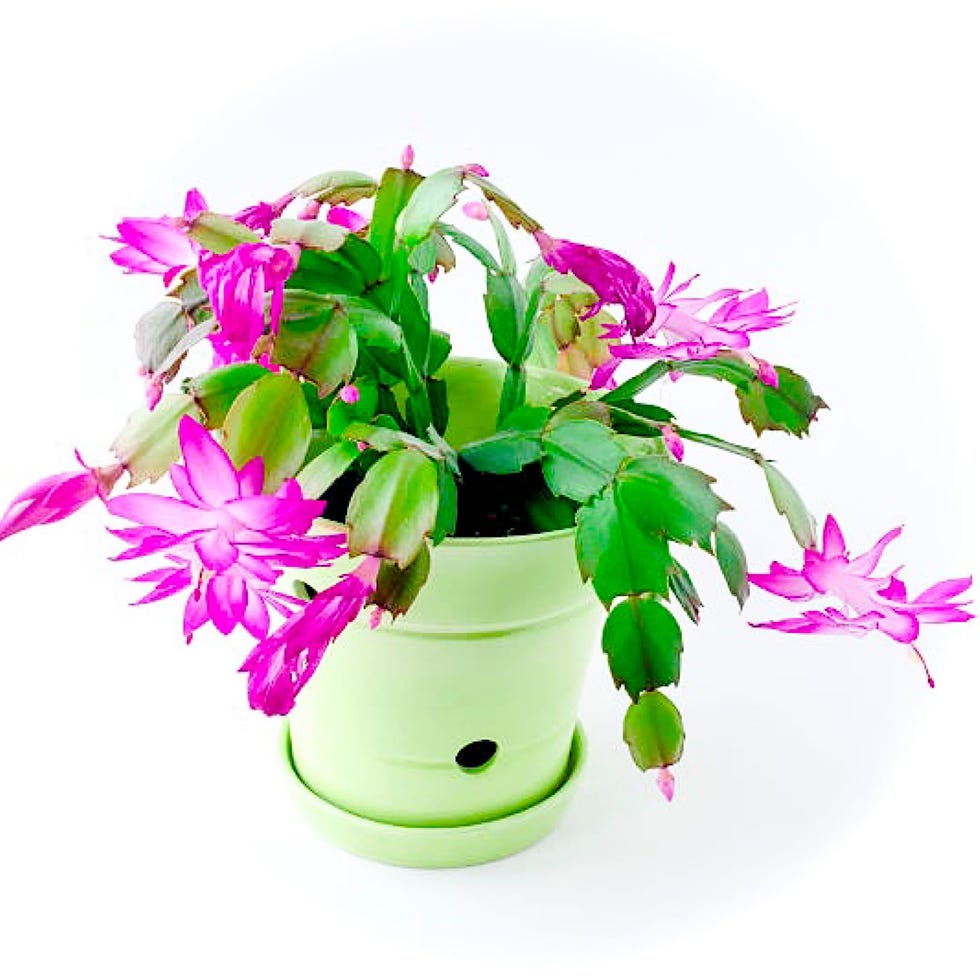Christmas brings all types of decorations, from mantel décor to Christmas plants galore which, of course, also look great on your mantel. You have mistletoe sprigs that hang from doorways and poinsettias that add festive splashes of red to every room. While these classics get a lot of attention, there's another pretty plant that deserves its own spotlight: the Christmas cactus.
They're one of those iconic seasonal blooms that pop up everywhere in December. Yet they don't exactly look like your stereotypical idea of spiky cacti—these plants have many long, flat green stems that each have a vibrant bloom at the end. The flowers can come in a variety of pretty colors, including red, different shades of pink, lavender, peach, and white, making them a beautiful Christmas gift idea, too. They can live for more than 100 years when cared for properly! And the best part is they're pretty darn low maintenance. Simply follow these Christmas cactus care tips to make the most out of your pretty holiday plant.
How often should I water my Christmas cactus?
A Christmas cactus is a succulent, so it absolutely can't tolerate soggy feet. Water only when the surface feels dry to the touch. If the flat stems get soft and mushy, you're overwatering. If the stems look shriveled, you're probably under-watering. You don't want to overwater a cactus, which is actually good news because you can leave them alone for days at a time.
How should I care for my Christmas cactus?
Start by giving your plant bright indirect light. You can fertilize a Christmas cactus with half-strength balanced houseplant food every month during the growing season from late winter to early spring, though it's not entirely necessary. It's also helpful to pinch back the stems after they're done blooming in mid-winter in order to promote branching, which yields more flowers. It also keeps the plant looking neat and the stems from getting too heavy and breaking off.
And while it is relatively low maintenance to care for this plant, there are some common Christmas cactus pests to be on the lookout for: fungus gnats, mealybugs, and spider mites. If you detect small flying bugs or telltale signs like insect webbing, use an insecticidal soap and consider repotting your plant.
Why isn't my Christmas cactus blooming?
Christmas cacti are "short day" plants, meaning they need 12 to 24 hours of uninterrupted darkness starting in September to bloom. Place your cactus in a room that's not used in the evenings and protect it from any outside light sources, such as a streetlight. Even a teeny-tiny amount of outside light can interrupt its day/night cycle and prevent blooming.
And though you've done everything right, there's a chance that your plant may not bloom because it could be another type of holiday cactus. A Christmas cactus looks incredibly similar to a Thanksgiving cactus and Easter cactus, which are named for the holidays closest to their bloom times.
The way to tell them apart is to look at the flattened stems, which are essentially the "leaves" of these plants. Christmas cactus stems are more tear-dropped in shape with purplish-brown pollen-bearing anthers on the flowers. The Thanksgiving cactus has saw-toothed stem edges with yellow pollen, and the Easter cactus has more rounded stems with little bristles on the segments. But don't worry, no matter what kind you have, they all require the same care.
How do I propagate a new Christmas cactus plant?
It's as easy as can be! Simply pinch off a few stem cuttings that have several segments, let them dry out for a day, then poke the cut end into moist-potting soil (preferably, cactus soil). You also can dip it into rooting hormone first, though that's not an essential step. In a few weeks, tiny new leaf segments should appear.
Arricca Elin SanSone is a writer, editor, and content creator who specializes in lifestyle and gardening. With a background in health reporting, she applies these same research skills when writing about the science of growing things. She trials new plants in her expansive garden, and her houseplant collection consists of 60+ varieties. Arricca has written thousands of articles for publications such as Country Living, House Beautiful, Good Housekeeping, Prevention, VERANDA, Southern Living, and more. She’s happiest when digging in the dirt, baking, or spending time with the people and dogs she loves.

















